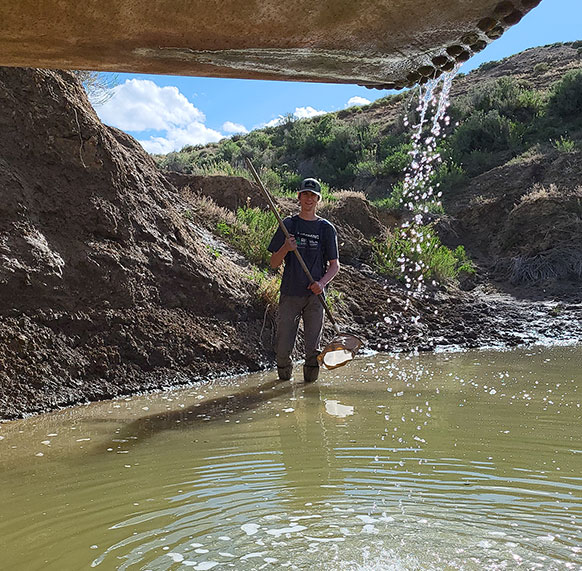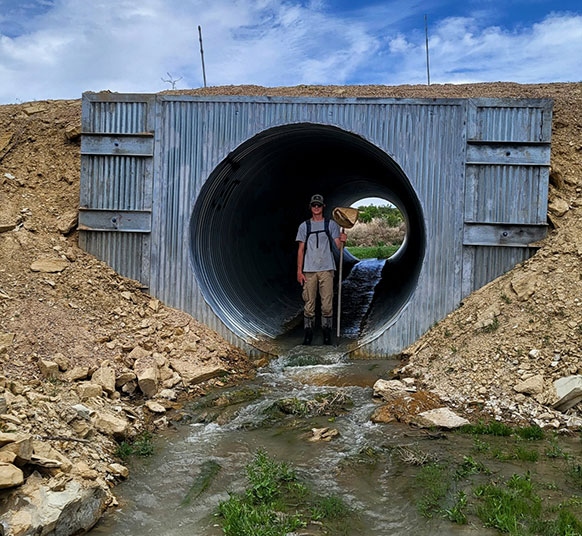UW Undergrad Publishes Research on Impacts of Salinity and pH on Wyoming Fish
Published August 27, 2025

UW student Miles Milbrath samples aquatic invertebrates and northern plains killifish in a culvert pool near Kaycee. The fish in this area depend on the pool for habitat and survival. (Audrey Lindsteadt Photo)
An undergraduate at the University of Wyoming is the lead author of a paper looking at how Wyoming fish survive harsh conditions.
Titled “Evaluating How Growth and Diet of Native Freshwater Fishes Change in Response to Salinity and pH in a Semi-Arid Landscape,” the paper was published this week in the international, peer-reviewed, scientific journal Fishes.
Miles Milbrath conducted the research as an undergraduate at UW and is the lead author of the paper, which is co-written by graduated student Audrey Lindsteadt and Lusha Tronstad, who serves as the lead invertebrate zoologist for UW’s Wyoming Natural Diversity Database and also is an adjunct faculty member in the Department of Zoology and Physiology.
For the project, Millbrath studied fathead minnows and northern plains killifish in intermittent streams around Wyoming.
“Freshwater fish ideally like a salinity that’s low and a pH that is neutral,” says Milbrath, who came from Durand, Ill., to study fisheries management at UW. “We’ve found streams that are double the salinity of normal ocean water in the middle of Wyoming. Using the fish’s ear bones, called otoliths, we can understand how much effort they're putting into their growth each year. We also studied their stomach contents to correlate the salinity and the pH with what they’re eating. There’s a lot of variability with the diet, but less energy was directed toward growth with higher salinity and a pH that’s more basic.”
Instead, the fish had to use more energy to flush out the salt and try to survive the harsh environment.
The research was possible thanks to the Wyoming Research Scholars Program (WRSP). Part of UW’s Science Initiative, the program pairs undergraduate students with faculty mentors to participate in cutting-edge, funded research. Milbrath chose Tronstad’s lab and began by assisting two of her graduate students, who encouraged him to develop his own research projects -- the publication with Lindsteadt and another soon-to-be-published paper with Samantha Poratti, a master’s degree student studying native mussels near Bear River in southwest Wyoming.
“I think every undergrad, if they’re interested in science to some degree, should do undergrad research where they’re in charge of managing a project and doing their own methods, lab work and writing up a manuscript to have it published,” Milbrath says.

Miles Milbrath poses for a photo in Upper Marsh Creek, a tributary of Flaming Gorge Reservoir, while surveying for aquatic invertebrates and fish inhabiting the stream using a dip net. (Audrey Lindsteadt Photo)
Most undergraduates who participate in research list it as one of their most impactful experiences. What’s more, many employers and almost all graduate programs desire these experiences in candidates. However, the majority of college students do not have access to hands-on research experiences -- something the WRSP program and other programs at UW aim to change. Even so, having an undergraduate become the lead author of a paper is even more rare.
“I’ve been doing this job for 16 years, and Miles is only the third undergraduate I’ve worked with who has had the determination to be the lead author on a paper,” Tronstad says. “They learn a lot in the process of writing a paper, and I think it’s excellent to contribute knowledge globally on something they put that much effort into.”
These types of undergraduate research experiences weren’t available when Tronstad was in school.
“I am a huge fan of WSRP,” she says. “It allows students to use everything they’ve learned in their degree and put it together to make something that they can be really proud of. It will follow them all of their careers.”
Milbrath stayed on at UW for his master’s degree after graduating last December and now mentors a WRSP student himself. He hopes to one day work for a fish and game department in fisheries management and believes the publications will give him a leg up.
“Understanding the implications and effects of lack of water on these fish is important,” Milbrath says. “It was a pretty small-scale project, but it does have broader implications. There are a lot more sensitive species like trout that are affected by different salinities and pH. Lack of water, the pooling of water and not being able to escape these harsh environments is applicable throughout the West.”

